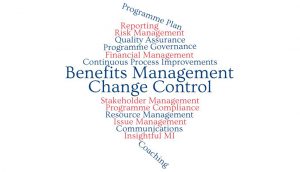What Makes a Good PMO?
Project Management Office – what makes it successful? Dean Isbitt, Associate Senior PMO Manager shares his thoughts on what makes a good PMO.
Before starting, it’s worth mentioning that much has been written on the subject of PMOs, their potential value at project, programme and portfolio levels, and possibly every facet that could contribute to the success of the function (just type ‘PMO’ into your search engine!).
Like so much in the world of project, programme and portfolio management, continual strides are being made to deliver more efficiently and effectively. This progression means that current thinking is constantly challenged and improved. As a result, content continues to be updated with enhanced approaches that deliver increased value.
That said, the basis on which PMOs are founded continues to remain as important as ever. It is one of the key capabilities required for successful delivery…
To provide insightful MI to inform senior management’s decision making, support the identification and realisation of outcomes and benefits through the delivery of projects and programmes to agreed time, cost and quality.
We are all very familiar with the role that PMOs play in support from a Project Analyst or a Head of Portfolio Management Office. The core services covering techniques, processes and standards.
A good programme management office, whether one person or a team, must have in-depth practical knowledge readily applied across all these areas:
However, PMOs are potentially able to play a significant role in helping organisations drive and deliver their change agenda. So, I wanted to touch on seven areas of the Programme Management Office role that I have found vital when creating and maintaining an effective function. This list is not exhaustive but covers areas that I find repeatedly cropping up and help ensure the PMO is effective, adds value, and perceived as a driving force behind the programme.
1. Understanding what is needed from the PMO
We all know that a PMO needs a clear vision and purpose to be effective and deliver short to medium term value. Much has been said of having a clear remit and direction along with senior management sponsorship, but on too many occasions PMOs are seen as the panacea for ineffective delivery, or just a need because everyone else has one.
From experience, we know that a good PMO can add value. But a PMO without direction or misaligned with senior management’s expectations is quickly perceived as an ineffective overhead. The perception is frustrating for senior management who want to see something happen, and the PMO, who may be working feverishly but focussed on the ‘wrong’ (so to speak) thing.
PMOs have a responsibility to understand the reason for their existence, in the form of a charter or a minimum agreed ToR.
In the absence of either of these, a clear positioning must define:
- What the PMO will do.
- How the PMO will deliver short and medium-term value.
This positioning can then be turned into a 30 or 60-day action plan and replayed to the Programme Manager for their approval.
Forcing this approach is likely to lead to a clear picture of the raison d’être, even if the initial draft is challenged and pulled apart – at least this way clarity is created and a firm footing on which the PMO can move forward. Once agreed, the relevant parties must sign up to the plan and approach. If there is any misalignment, there is the likelihood that:
- The PMO will not meet short-term expectations. As a result, be asked to undertake tasks that overload or cut across the work they have scheduled, or are consequently micromanaged by the Programme Manager
- The Programme Manager and senior management will get frustrated with the lack of pace
- There are repercussions for the programme. Control will be deemed ineffective, or the PMO will fail to address the problems that they were brought in to remediate, but just didn’t know about
- The need for a PMO is challenged
2. Organisational Awareness
One size doesn’t fit all when it comes to setting up and running an effective PMO. This view is discussed in some detail as part of P3O, referencing Portfolio, Programme, Project and Risk Management (P3RM) as defined in P3M3. In reality, it is easy to fall into the trap of reusing processes and techniques that have been used before, especially when:
- They are already proven to be effective, though in a different organisation
- There is a need to deliver value quickly to senior management and to support the programme, and
- The collateral is sitting in a folder just waiting to be used!
Amongst other things, it’s important to understand the organisation’s level of maturity now, as well as the strategy for achieving any future state before embarking on implementing changes as:
- The existing processes, techniques and standards may well have been put in place to align with the organisation’s maturity level
- These changes may well prove to be more difficult to embed with the programme team in comparison with other organisations
- Any changes need to be aligned with the organisation’s change framework and not done in isolation. This will cause an immense amount of confusion. See section 7. – Working with the Portfolio Management Office
- Although the goal may be to ensure there are effective controls in place that help the programme team deliver efficiently and effectively, this could prove counterproductive in the short-term if the change is not managed correctly.
That said, the need for continuous improvements remains an integral part of the PMO’s role, but must be done in the right way…we practice what we preach!
3. Standards, Processes & Techniques
I was going to gloss over this section as I’ve already mentioned that a good PMO will have an in-depth practical knowledge of techniques, processes, standards as well as toolsets associated with various key methodologies, e.g. waterfall, agile, etc.
Once the programme is set up with standards and processes in place, the PMO will ensure timescales for all routines are adhered to. This will provide effective governance and controls. Reliance is placed on the programme team and particularly project managers to play their part, whether it is keeping their logs updated or providing timely and concise reporting.
However, project managers often see governance as a low priority when they are fighting fires or generally have pressure on their time. This is when the PMO needs to ensure that all governance and controls are continually maintained. They must use their experiences to explain why time needs to be made and the consequences to both projects and the programme and taking the correct remedial action.
Another example is when requests come from the Portfolio Management Team. These are often perceived as unjustified ‘fire drills’, sometimes with little or no context. The PMO can usually deal with these as they are often data-driven or requiring information that has already been sourced. Or where there is no justification, just pushed back. However, where input is required from the programme team, the PMO will need to articulate the importance of prioritising. This tends to have originated from senior members of the organisation and needed urgently for key decision making.
The need for a good PMO to have in-depth knowledge cannot be understated:
- Being knowledgeable in each of these disciplines, in theory, and with practical experience at project, programme and portfolio levels.
- The ability to communicate succinctly and eloquently to the team.
- Understanding how these disciplines interlink and to be able to communicate the bigger picture. From the benefits and consequences – to the team and stakeholders.
- Understanding the pressures project managers are under and therefore making adherence to governance and controls easier for them and therefore more likely to be done!
4. Getting the right balance between support and directive control
When I first started in PMO, I was told it was where ex‑project managers went to see out their days. The statement was inaccurate and slightly offensive. Fortunately, those days are long gone with PMOs now a truly integral part of the delivery function. However, there is one thing about the original statement that I can relate to. The PMO understanding what it’s like to be on the sharp end of a project. Maybe a project that is flagging RED, slipping dates like there is no tomorrow and senior stakeholders potentially looking for someone to ‘blame’.
As a key member of the programme team, the PMO needs to be able to undertake their role effectively. But they must to be mindful of the capabilities and experience across the team and pressures at any given time. A good PMO needs to be able to assess the position quickly and accurately through effective collaboration and take the appropriate action.
Example:
We have a scenario where a project manager has not submitted their weekly progress report in line with agreed timescales. As a good PMO, you message the PM and receive a response that they haven’t had the time and will do it in the next hour. What do you do?
If delayed beyond the hour, the project won’t feature in the consolidated reporting that goes to senior management and key stakeholders. This will undoubtedly result in the portfolio management office contacting you and your programme manager. As a result, there may be a perception that the programme is losing control.
- Do you have confidence that the report will be completed?
- Are you aware that the PM is under pressure and needs help?
- Is there a reoccurring theme with this particular PM?
While this is a pretty stock scenario, the same thought process will also be applied to other situations. Reactionary, single actioned ‘policing’ really has no place when working in or creating a high performing team. However, individuals who avoid their responsibilities only put pressure on other team members, and this needs to be addressed differently.
The key is that a good PMO creates an excellent collaborative working relationship with all the members of the team. They can make the right call immediately, keeping the impact to a minimum and providing the correct level of support.
5. Flexibility
I’m expecting some horrified faces when I confess to being involved in many non-standard PMO activities. By non-standard, I mean things that don’t fall within part of a PMO standard service but which impact delivery. Here is an example of an issue of a different kind that I resolved in absence of the Head of Operations:
Our colleagues were regularly using an accessible toilet designed for people with disabilities. Simply because it was close to their desks. They didn’t need to use these facilities, but in doing so, they were forcing a project colleague to the other side of the building. These actions were creating negative feeling amongst the team. High performing teams only emerge where there is an environment of respect and trust among colleagues.
The example above is not an everyday event, yet it demonstrates that a PMO needs constant awareness. Flexing to challenges that may adversely impact the delivery, or acting as an enabler, are additional ways to elevate the role and add value.
6. Stakeholder Management
This section doesn’t solely apply to the programme management office, but to every member of the programme team who has a responsibility to ensure effective management of stakeholders.
Stakeholder plans and maps aside, the exposure that the programme management office has with stakeholders means they regularly engage with individuals face-to-face and through regular reporting. Good PMOs actively uses these opportunities to create trusted relationships that can be leveraged later. While this can be of great benefit, take care that the content falls in line with formal reporting and communications. Or with the specific approval from the programme manager. Beware that an unplanned corridor encounter with a key stakeholder can catch a person off-guard. This could have a lapse in focus that set hares running!
In addition to proactive stakeholder management, there are various reactive situations that a PMO will find themselves in. Again by being around stakeholders and keeping eyes and ears open. While project and programme managers tend to be primarily involved in managing stakeholders, there is only so much ground they can cover. A good PMO can become an extension to their radar by reporting back issues seen or heard on the ground. Concerns can then be validated and proactively managed.
7. Working with the Portfolio Management Office
The final area that I want to touch on is the relationship with the portfolio management office.
In many organisations, I’ve found that the programme manager sources the programme management office lead. So, there is a single reporting line and relationship. The portfolio management office is recruited by and feeds into senior management working as a central hub. The two offices are separate, have their own agendas and drivers and to some degree, tend to work in isolation. And this is where the problems begin:
- The programme management office doesn’t know or want to know what the portfolio office is doing and vice versa.
- The portfolio office becomes frustrated that their requests are ignored, dates missed, and reporting is sub-standard. They believe the programme office needs to understand the bigger picture. The programme office believes the portfolio office doesn’t have a handle on the reality of trying to deliver complex programmes in a demanding environment and their requests and consolidated portfolio information add little value.
The programme office doesn’t want to disclose too much to the portfolio office as they see them as a policing function. ‘If we don’t tell them anything, they’ll leave us alone!’
The reality is that both offices are part of the organisation’s PMO function. Both want to achieve the same aim, just at different levels. A valued programme management office needs to create a working relationship with the portfolio office.
You can realise countless benefits by leveraging the combined experience and capabilities, alongside having open discussions:
- The programme office becomes an extension of the portfolio office.
- The ability of the programme office to react quickly to requests from senior management. This should be via the portfolio office as they understand why information is needed.
- Regular feedback is given to the portfolio office on standards, processes and techniques to support continuous improvement. It will uplift in maturity across the organisation.
- Opportunities are available for the programme office to trial. Test any new tools or processes, rather than having them thrown over the fence and not delivering full benefits.
- The portfolio office can gain greater insight into programmes through a tighter relationship, which adds more value to senior management.
These are examples that I have experienced where a quality PMO adds additional value to the programme and the organisation.
If you want to know more about how we at Acceler8 can help you achieve success, please contact us.








